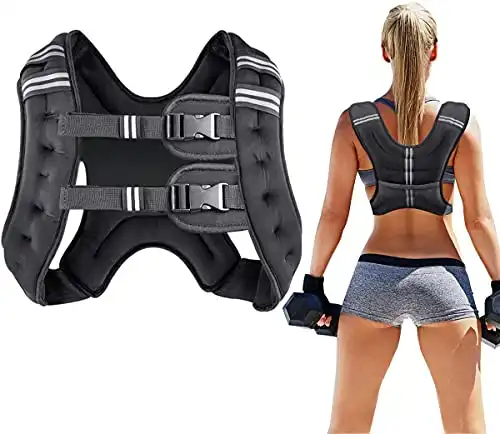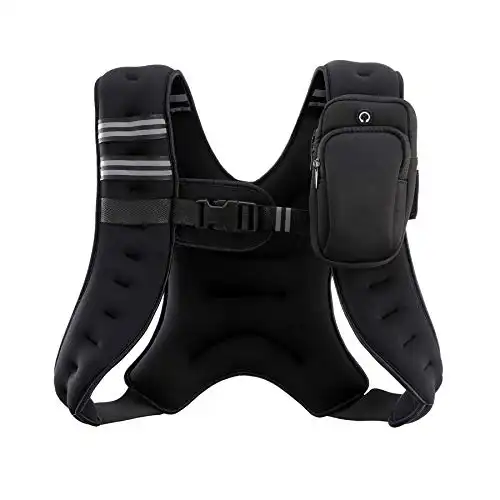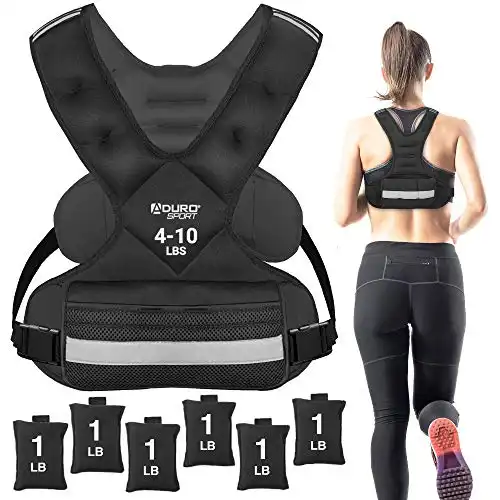Learn all about rucking, a low-impact exercise that requires you to carry a weighted backpack. Discover the benefits of rucking, sample workouts and recommended gear.
Are you looking for a good workout routine that will get you in shape and also help you prepare for any unforeseen circumstances? Then you should consider rucking.
The hashtag #rucking has already gotten close to 20 million views on TikTok making it what we call a “trend” in fitness.
So, what is rucking? Rucking is simply walking with a weighted pack on your back. It’s slightly different than using a weighted vest for walking, which evenly distributes the weight across your body. Rucking can be done for recreation, fitness, or as part of military training.
It is a great workout because it exercises your whole body.
You’ll use your legs to walk, of course, but you’ll also engage your core muscles to stabilize the weight of the pack. And since you’re carrying extra weight in the bottom of the pack, you’ll also get a good cardio workout.
Keep reading to learn more about rucking, the benefits of this loaded pack workout, the best gear, and and tips to succeed.
Table of contents
What is Rucking?
Rucking is a form of fitness exercise that involves walking or hiking with a loaded backpack, typically known as a rucksack. The term “rucking” is derived from “ruck march,” a military term used to describe marching or walking with a heavy backpack as part of military training.
The concept of rucking has its roots in military training, where soldiers carry heavy loads over various terrains to build strength, endurance, and mental toughness. It’s an effective and practical way to train for the physical demands of carrying equipment and supplies during long marches or missions.
In the civilian fitness context, rucking has gained popularity as a functional and accessible form of exercise. People of all fitness levels can participate by simply putting on a backpack with some weight and walking for a set distance or duration. The added weight challenges the cardiovascular system, strengthens muscles, and enhances overall endurance.
People are now rucking in their neighborhoods, local parks and trails.
Rucking is a great workout for a number of reasons that I’ll cover next!
Benefits of Rucking
Rucking is basically adding load. By adding weight to your body, you are able to increase the intensity of your workout while also burning more calories. And by the way, this works with a baby too—if you’re carrying your 9-month-old on your back, yes, you’re rucking.
Here are some of the many benefits of rucking:
Increases Cardio Endurance
Rucking is an excellent way to get your heart rate pumping and build up your cardio endurance. Walking with added weight increases heart rate and improves cardiovascular endurance.
By carrying around extra weight, your heart and lungs have to work harder to pump blood and oxygen to your muscles.
Builds Strength
In addition to improved cardiovascular endurance, rucking will also help you build strength. Carrying around extra weight across long distances will force your muscles to work harder, leading to increased strength and muscle mass over time.
Carrying a loaded backpack engages various muscle groups, including the legs, core, and upper body, providing a functional full-body workout.
Rucking will make everyday activities like carrying groceries, heavy boxes or toddlers around seem easier.
Improves Joint Stability
Another benefit of rucking is improved joint stability. When you carry extra weight, your joints have to work harder to stabilize the added load.
This can help to prevent injuries in the future by strengthening the muscles and connective tissues around your joints.
Can Be Done Anywhere
One of the best things about rucking is that it can be done anywhere. All you need is a backpack and some weight, and you’re good to go.
Whether you’re hiking in the woods or walking around your neighborhood, you can get a great workout in by ruck marching.
Improves Mental Toughness
Rucking requires mental resilience, especially when carrying a heavy load for an extended period. It can help build mental toughness and discipline.
Carrying extra weight is hard. Every time I see someone with a baby on their back as they are hiking up the same mountain I am, I think to myself, “That is serious work!!”
Whether you’re looking to lose weight, build strength, or improve your cardiovascular endurance, rucking is a great option.
So what are you waiting for? Grab a backpack and start!
Choose the Right Weight for Rucking
In order to get the most out of your rucking workout, it’s important to choose the right weight for your body. Here are a few things to keep in mind when selecting the weight of your ruck:
- The weight of your ruck should be based on your body weight. A general rule of thumb is that your ruck should be 10% of your bodyweight to begin.
- If you’re new to rucking, start with a lighter ruck and gradually increase the weight as you get more comfortable with the movement.
- If you’re looking to increase the intensity of your ruck, go for a heavier weight. Just be sure that you can still safely and comfortably move with the added weight.
- When in doubt, err on the side of caution and go with a lighter ruck. It’s better to make your rucking workout a little easier than to risk injury by carrying too much weight across longer distances.
By following these guidelines, you can ensure that you’re choosing the right weight for your body and your rucking goals.
Rucking Gear
The most important piece of gear for rucking is, of course, is the load. You’ll want to find a backpack that’s comfortable to wear and has enough space to hold all the weight you’ll be carrying. Consider a waist strap for extra support.
As a matter of fact, a weighted vest is a great way to distribute the weight on your torso avoiding any back issues. If you have the funds to invest, it’s a worthwhile added piece of gear.
In terms of weight, you can use just about anything that’s heavy and won’t break if it falls on the ground. Sandbags, dumbbells, and water jugs are all popular choices. Start with a weight that’s comfortable for your lower back and gradually increase it as you get stronger.
Other important pieces of gear include good shoes, comfortable clothing, and a watch or some other way to track time. You’ll also need something to hold your water bottle, and you may want to get a belt to help distribute the weight of your backpack evenly.
Once you have all your gear, it’s time to start! Start by walking for 10-15 minutes to get warm, then put on your backpack and start walking.
Remember to keep track of time so you don’t overdo it, and to drink plenty of water throughout.
| Product Image | Product Name | Primary Button |
|---|---|---|
Pre-Workout Warm Up
Rucking is intense. Start with dynamic stretching to increase blood flow and flexibility.
Include leg swings, arm circles, hip circles, and torso twists. These movements help to improve range of motion and prepare the joints for the load they’ll bear during rucking.
Focus on joint mobility exercises for the ankles, knees, hips, and shoulders and neck. Rucking can put stress on these joints, and ensuring they are properly warmed up and mobile is essential for injury prevention.
Include ankle circles, knee circles, hip circles, and shoulder rolls.
Incorporate 5-10 minutes of light cardio, such as brisk walking without the rucksack. This helps elevate your heart rate, increase circulation, and gradually raise your body temperature.
A slightly elevated heart rate prepares your cardiovascular system for the more intense exercise to come.
Sample Rucking Workouts
There are many different ways to ruck.
You can do it solo or with a group, just for fun, or part of a training program. There are even fitness competitions.
Here are some sample rucking workouts to give you an idea of what it entails.
Beginner Rucking Workout
Start with a light backpack or rucksack filled with weight. Start with a weight that is comfortable for you to carry.
- Walk for 15 minutes (You can do this at a moderate pace or a fast pace, depending on your fitness level).
- After 20 minutes, stop and rest for 2 minutes.
- Then, continue rucking for another 15 minutes.
- Repeat this cycle again if you are up to it.
More Challenging Rucking Workout
Fore a more challenging workout, simply increase your weight or add some incline.
If you are on a treadmill, add incline. For an elliptical, add resistance. If you are outside, find a hill or a place to hike with some elevation.
Tips for Success
Here are some tips for successful rucking:
1. Start slow and build up your mileage gradually. Rucking is a low-impact exercise, but it’s still a workout. If you’re new to rucking, start with a short distance and add a bit more each time you go out.
2. Choose the right backpack. A good rucking backpack will be comfortable to wear and have enough room to carrying everything you need. Make sure to adjust the straps so that the backpack sits snugly against your back. Or, choose a weighted vest.
3. Wear the right shoes. Rucking is tough on your feet, so make sure you wear shoes that are comfortable and have good support. Running shoes or hiking boots are both good options.
4. Pace yourself. Rucking is not a race, so there’s no need to go as fast as you can. Instead, focus on maintaining a steady pace that you can sustain for the entire distance.
5. Be prepared for the weather. Rucking is an outdoor activity, so you need to be prepared for whatever the weather throws at you. Dress in layers so you can adjust to changes in temperature, and invest in a good pair of waterproof gloves and socks.
6. Stay hydrated. Rucking is a great way to stay hydrated since you’re carrying your water with you. Make sure to drink plenty of water before and during your workout. And if you’re exercising in hot weather, be sure to take breaks in the shade to stay cool. Don’t forget water bottles!
7. Go with a friend. Rucking is more fun with a friend, and it’s also safer. Having someone to workout with will motivate you to keep going, and you can help each other with any challenges along the way.
Rucking is a great way to get fit, and following these tips will help you do it successfully!




Leave a Reply